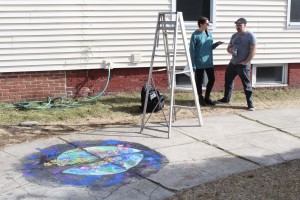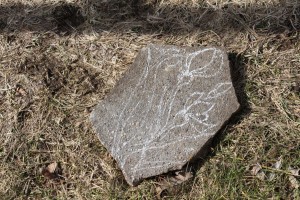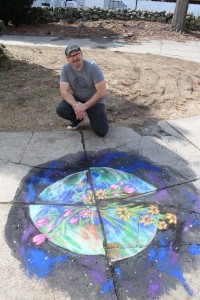Green: it’s the color of budding spring, the color of St. Patrick’s Day, and the color of eco-consciousness, which is rarely as top-of-mind as when the baby plants start busting out. So in this issue, we’ve covered all those bases, in our mix of articles and in our think-globally-but-keep-your-feet-on-the ground cover art by RI illustrator, sculptor, theatrical impresario and Beacon Charter High School for the Arts teacher and RISD Instructor Jason Robert LeClair, who, it turns out, is also an accomplished chalk artist and managed to turn cracks in the pavement into cracks in a plant-hatching world.
Motif designer Haley Nunes took a few minutes to chat about art with the multi-talented world builder.
Haley Nunes (Motif): Have you always been involved in making art?
Jason Robert LeClair: Yes. I started drawing, really getting into it and trying to make art my profession when I was 12. Started selling my art around 15 and never looked back.
HN: Is that what you do now, artistically?
JRL: Right now I focus more on scenic design and build. But I still do other things – I just started doing little monster mini figures for D&D, because it’s popular again … So I try to keep my hand in just about everything. But I try to do the street painting festival every year, because I have a lot of fun with that [the Street painting festival, run by the Providence Rotary Association, takes place annually in the fall, weather permitting]. I started life as an illustrator – this kind of grew out of that.
HN: So how did you get into that – into chalk art?
JRL: I was asked by a former student’s parents to do their square for the street art festival in 2007. That was the first time I had ever done street painting. I was doing the squares for years after that, and the Rotary Club asked me to appear on The Rhode Show in 2012 to represent the festival. So I’ve done that for them for four years, so I can help out in some way.
HN: What should you be aware of if you’re going to do art in this medium?
 JRL: I look for what sort of material I’m going to be working on – if it’s too rough, then I have to wear different gloves, etc. I don’t like working where any cars have parked, because they leave an oil slick. There was one year the festival was in the street – where it used to be – and it was not pleasant. Every time we tried to lay it down, [the pavement] kept rejecting it. If the surface is really rough it’s difficult because you don’t get as many details as you want.
JRL: I look for what sort of material I’m going to be working on – if it’s too rough, then I have to wear different gloves, etc. I don’t like working where any cars have parked, because they leave an oil slick. There was one year the festival was in the street – where it used to be – and it was not pleasant. Every time we tried to lay it down, [the pavement] kept rejecting it. If the surface is really rough it’s difficult because you don’t get as many details as you want.
Like today’s piece, I just thought it would be appropriate to throw it on cracked concrete. So, it’s a driveway that’s actually from the turn of the last century. It’s really, really old with lots of wear and tear on it, which was perfect for the piece.
So I guess what I’d advise someone is to ask, “Why are you doing the piece? What do you want out of it?” If you need it to … have tons of fine detail, don’t choose a surface that’s going to be really rough. If you’d like to do something where you’re not creating an illusion, but you’re admitting that it’s art, a rough section is just fine. Also check out foot traffic – you may not want lots of people walking on it.
HN: And weather…
JRL: There’s that. This morning I was out here with my heat gun, drying last night’s rain off the center section so I could get started.
HN: What was your process for this project?
JRL: This was rather quick. It was the call from the rotary club and the call with you. I had an idea from our conversation of what you wanted, so I started to scout locations. Finding this as the

location, being that it’s somewhat familiar to me was great and it seemed to work with the concept. I took some location shots and then did all of my sketches based on those shots.
HN: What are your influences? Or any sources of inspiration?
JRL: A lot! In my regular illustration, I really love Alphonse Mucha, but I also draw a lot from Lenny McCrea and I have a lot of fun with my characters – I like to think of Henson and Fraud and the Creature Shop illustrations and that sort of thing. Those are my biggies. I do take a lot of drama and lighting effects from the Baroque era and I think most illustrators do at this point – Caravaggio and things like that.
HN: Any advice for aspiring chalkers?
JRL: Yes! Learn how to use the material on paper first. Understanding what it can do on different surfaces is important. Understand [that] before you lay out onto concrete – because that will be a whole different animal. Use pastel chalks – you don’t want just straight Crayola chalk. You want something that’s got a little more tooth to it – more pigment in it. It’s an expensive process – you’re going to go through a lot of chalk, depending on what the surface is. The smoother the surface, the less chalk you need. Map it out on a big piece of butcher paper first – and make a stencil, that can make your life much easier.
And don’t underestimate the power of water. Water is your friend. There were points in this piece where there was so much dust that was flying up that the piece itself became kind of muddy, and “pastelled out,” for lack of a better term. Kind of cloudy – but a spray bottle of water over the whole thing brightens it right up. Then you can put a final layer on it and brighten it.
HN: That’s kind of ironic.
JRL: It is, I know, because then it washes all away with water. Although they tell me, whenever I do the Rhode Show, that they last for months.
HN: Really?
 JRL: Because it’s not a high traffic area, so that drawing will stay down well into the next season. It’s kinda cool.
JRL: Because it’s not a high traffic area, so that drawing will stay down well into the next season. It’s kinda cool.
HN: Tell us about this year’s show.
JRL: The street art festival is usually in September or October. Last year it actually got rained out. This year, check the Providence rotary site [providencerotary.org] for the dates when they’re announced. But that is probably the best surface ever to work on — the skating rink, which is so beautiful. It’s gorgeous. That’s the one I usually do, but there are others – there’s one in Harvard Square and one at Wrentham Outlets that just started last year.
HN: Awesome. Thank you very much!



